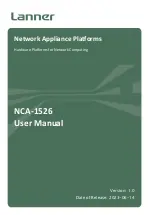
Glossary
ELSA LANCOM Business
143
Glossary
쮿
10BaseT –
Twisted pair; 10-Mbit Ethernet
connection type; RJ45 network connection
쮿
10Base2 –
Thin Ethernet; Cheapernet; 10-
Mbit Ethernet connection type; BNC network
connection
쮿
10Base5 –
Thick Ethernet; 10-Mbit Ethernet
connection type; AUI or SUB-D 15-pin net-
work connection
쮿
100BaseTX –
Twisted pair; 100-Mbit Fast
Ethernet connection type; RJ45 network con-
nection
쮿
1TR6 –
German national ISDN; formerly com-
mon D channel protocol in Germany; only pro-
vided by Deutsche Telekom on special
request
쮿
ARP –
Address Resolution Protocol, a proto-
col of the
TCP/IP family. ARP resolves IP
addresses to associated MAC addresses.
쮿
Asynchronous transfer –
A process is re-
quired in serial data communications to es-
tablish synchronization between the
transmitter and receiver, to permit the receiv-
er to identify the beginning and end of a trans-
mitted character. This structure is provided
during asynchronous transfer by marking
each byte to be transmitted with a start bit
and one or two stop bits. This start-stop pro-
cess is one of the most common transfer pro-
cesses, especially in the microcomputer
sector, as it can be realized technically with
relative ease.
쮿
AUI –
Attachment Unit Interface = Port for
general network connections.
쮿
B-chan. –
ISDN data transfer channel (64
kbps); an ISDN basic rate interface has one D
channel and two B channels.
쮿
Basic Rate Interface –
ISDN subscriber
connection with two
bearer channels
(64 kbps) and a signal channel (16 kbps). The
S
0
interface is the subscriber interface
used by the Basic Rate Interface.
쮿
BNC –
Common connector type for Cheaper-
net (Thin Ethernet). This connector is also
known as T-BASE2. A T connector must be
used to connect devices equipped with BNC
sockets.
쮿
Bridge –
A bridge is a connection between
two networks with identical layer-2 struc-
tures in the
OSI model. Such a bridge can
consist of two devices connected to one an-
other by a data transfer route. This constella-
tion is known as a remote bridge.
쮿
Broadcast –
Broadcasts are special data
packets sent out to all stations set to receive.
In Ethernet networks, these data packets are
marked with the target address FFh FFh FFh
FFh FFh FFh (i.e. to everyone).
쮿
Burst mode –
Burst mode is a special form
of data packet transfer used in Novell net-
works in which several data packets are sent
consecutively without confirmation of receipt.
쮿
CEPT –
Conférence Européenne des Postes
et des Télécommunications = the European
telecommunications standards board.
쮿
Channel bundling –
Bundling of both ISDN
B channels to a logical connection in order to
double the transfer speed.
쮿
Client –
Client = Workstation. A client is a
user of services provided by a
server.
쮿
CLIP –
Caller Line Identification Parameter =
Subscriber number of the caller that can be
transmitted in the ISDN.
Summary of Contents for LANCOM Business LC-4X00
Page 1: ...Manual ELSA LANCOM TM Business No 20857 0999...
Page 4: ......
Page 10: ...Content ELSA LANCOM Business X...
Page 22: ...Introduction ELSA LANCOM Business 12...
Page 42: ...Configuration modes ELSA LANCOM Business 32...
Page 112: ...Operating modes and functions ELSA LANCOM Business 102...
Page 146: ...Workshop ELSA LANCOM Business 136...
Page 152: ...Appendix ELSA LANCOM Business 142...
Page 160: ...Glossary ELSA LANCOM Business 150...
Page 170: ...Index ELSA LANCOM Business 160...
















































